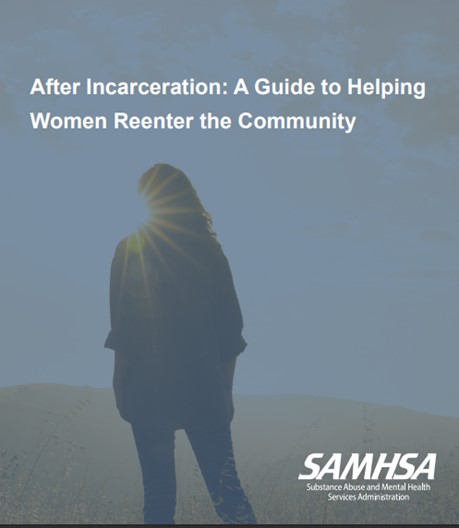After Incarceration A Guide to Helping Women

After Incarceration: A Guide to Helping Women
Reenter the Community
After Incarceration A Guide to Helping Women – The Issue – As of 2016, over 1.2 million women in the United States were incarcerated in prison or jail, on probation, or on parole. Since 2000, the rate of women’s incarceration in jails rose over 26 percent, whereas the jail incarceration rate for men decreased by 5 percent.
When women are released from jail or prison, they are often ill-prepared to reencounter and address the serious problems they faced prior to incarceration, such as victimization, an unstable family life, difficulties in school, limited work experience, financial issues, poverty, substance use disorders, mental health issues, a lack of vocational skills, and parenting difficulties.
Women also tend to face new concerns upon reentering society, such as legal issues, financial restitution, and new trauma or re-traumatization that they experienced while incarcerated.
There are few randomized studies that have identified gender- responsive, evidence-based practices for women’s reentry. In many communities, women receive the same services that were originally designed to serve men being released from jail or prison.
However, new findings, such as those from the Office on Women’s Health’s 2012–2015 Reentry Enhancement Project, are helping to identify effective approaches for women’s reentry.
This guide provides an overview of promising practices that corrections and community-based service providers should consider in supporting women’s transitions from correctional facilities to the community.
Gender-responsive criminal justice approaches acknowledge women’s unique pathways into and out of the criminal justice system. These approaches address social factors such as poverty, race, class, gender inequality, and culture.
The promising practices presented here align with a theoretical framework, created by Bloom, Owens, and Covington, that explains the complex dimensions of a woman’s experience when reentering the community following incarceration.
This framework includes the following:
• Pathways that lead to women’s justice involvement
• Racial and ethnic disparities and the intersectionality of race and gender
• Women’s development and relational approach
• Trauma prevalence and its effects on women
• Substance use disorders and their effects on women
The steps presented in this guide align with this organizing framework to ensure a comprehensive approach to women’s needs during reentry.
A compliment to this guide is the SAMHSA publication Principles of Community-based Behavioral Health Services for Justice-involved Individuals: A Research-based Guide. This publication can provide more overarching guidance on what key principles should guide the work of community-based practitioners serving individuals involved with the criminal justice system.
How to Use This Guide
This guide provides an overview of topics and resources for serving women who are reentering the community after a period of incarceration. It is intended to increase knowledge of specific issues that women often face during reentry and to provide relevant resources to providers who can help them succeed. The guide is presented in a “checklist” format to provide a brief overview of considerations necessary when working with women who are justice involved.
Intended Users
This guide was created for individuals who provide or coordinate reentry services for women involved in the criminal justice system (e.g., corrections staff, reentry organizations, substance use disorder and mental health treatment providers, reentry specialists, peer specialists, individuals who work with justice involved women). Readers do not have to have an official “forensics” position to benefit from this.
CHECKLIST AT A GLANCE
![]()  Identify Critical Reentry Needs
 Identify Critical Reentry Needs![]() Address Substance Use Disorders
Address Substance Use Disorders![]() Build Links to Mental Health Care
Build Links to Mental Health Care![]() Address Physical and Reproductive Health Care
Address Physical and Reproductive Health Care![]() Provide Culturally Competent Services
Provide Culturally Competent Services![]() Provide Trauma-informed Services
Provide Trauma-informed Services
![]() Build Healthy, Trusting Relationships
Build Healthy, Trusting Relationships![]() Reestablish Family Relationships
Reestablish Family Relationships![]() Facilitate Payment of Justice System Fines and Fees
Facilitate Payment of Justice System Fines and Fees![]() Increase Self-efficacy Through Certified Peer Specialists
Increase Self-efficacy Through Certified Peer Specialists
1. Identify Critical Reentry Needs
Women’s needs during reentry can be different from men’s due to differing experiences and relative access to critical resources (e.g., history of abuse, poverty, substance use, family support, dependent children).
Prior to a woman’s release from prison or jail, individuals working with her should assess her needs and develop a reentry plan to ensure that the following are identified and ready to assist with the transition: community-based mental health and substance use treatment providers, healthcare coverage providers (e.g., Medicaid), housing and other social supports, and advocacy organizations. An effective reentry plan should be strengths-based, trauma- informed, and individualized.
Many of the available needs assessment tools are “gender-neutral,” but needs assessments for women are more comprehensive and accurate when they are gender-responsive. Several commonly used tools that address women’s needs are described in the publication Risk-needs Assessments Appropriate for Women Offenders.
Effective reentry services for women should address needs based on the gender-specific issues involved when women interface with the justice system. Based on the guiding framework set forth for this document, the following critical needs should be discussed and included in the reentry planning process:
Pathways:
• Housing providing distance from prior abusive relationships
• Transportation
• Clothing
• Income and employment, often to support children/single-parent households
• Identification (e.g., Social Security card, birth certificate, government ID)
• Education
Racial and Ethnic Factors:
• Past and potentially present systemic barriers or disparate treatment of women based on racial or ethnic differences should be considered when providing assistance across all critical areas of need
• Programming that meets the needs of women of a specific race, ethnicity, or culture can lead to improved outcomes compared to programs created for the general population or the dominant culture of that community; for example, the Diane Wade House provides Afrocentric transitional programming for women reentering the community, increasing their participants’ access to culturally specific treatment and services.
Relational:
• Legal support, including obtaining or maintaining child custody
• Family reunification, including parenting education and planning to resume custody and care of minor children
• Domestic violence or intimate partner violence interventions
• Childcare
READ MUCH MORE INSIDE…
“AFTER INCARCARATION A GUIDE TO HELPING WOMEN” $17.46

Click on the Blue Button Below for Instant Access!
Our 100% Money Back Guarantee:

If for any reason you decided within 30 days that “AFTER INCARCARATION A GUIDE TO HELPING WOMEN” isn’t for you, simply notify us by email and we’ll gladly refund your money – no questions asked. That’s our Ironclad Guarantee!
The risk is entirely ours! You absolutely have nothing to lose!
Your name and email will Never be shared, sold, or given to anyone.
We keep our subscriber’s privacy sacred. We do not sell or rent your personal information to other parties. What’s more you can always unsubscribe at any time!
Warmest Regards, Coyalita
Behavioral Health Rehabilitative Specialist & Addiction Counselor
Copyright © 2021-2024 Thresholdlivecoyalita.com All Rights Reserved Privacy Policy – Earnings Disclaimer – Terms of Use – Contact Us




